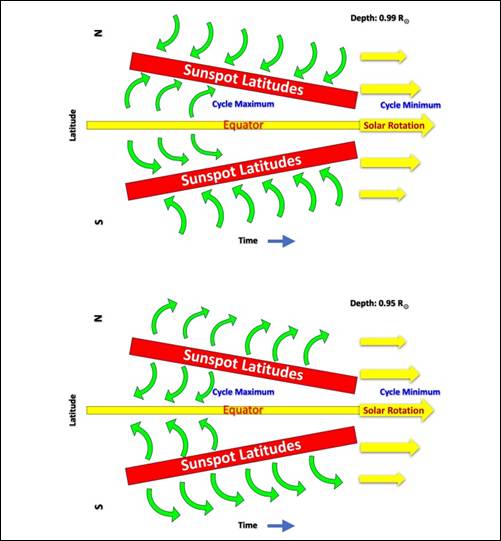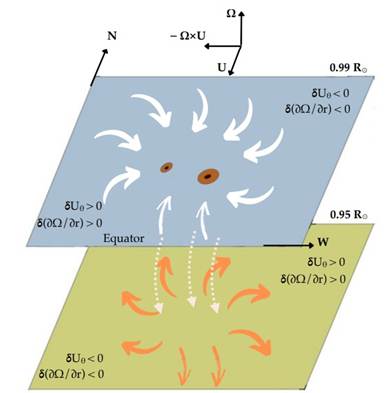Ministry of Science & Technology
Scientists Chart the Sun’s Subsurface Weather Tied to Its 11-Year Activity Cycle
Posted On:
29 APR 2025 5:05PM by PIB Delhi
An international team of solar physicists have traced giant tides of plasma beneath the Sun’s surface at a region called near-surface shear layer (NSSL). The plasma currents shift with the Sun’s magnetic heartbeat and could have far-reaching influence on space weather and Earth.
The near-surface shear layer (NSSL) extending to about 35,000 km in depth is a critical region beneath the Sun’s surface. It is marked by distinct rotational behaviours that vary with depth and by changes, over space and time, that relate to active region magnetic fields and the solar cycle.
A study led by astronomers from the Indian Institute of Astrophysics (IIA), an autonomous institute of the Department of Science and Technology (DST) have probed the dynamic “inner weather” of the Sun - plasma currents just beneath its surface at the NSSL, that pulse in step with its 11-year sunspot cycle.
In the research published last week, in ‘The Astrophysical Journal Letters’, researchers from the IIA, Stanford University (USA), and the National Solar Observatory (NSO, USA) have traced how these hidden flows shift over time, potentially reshaping our understanding of solar dynamics in general and how the Sun’s interior connects to its outer magnetic behaviour in particular.
Employing helioseismology—an advanced technique that tracks sound waves as they travel through the Sun—the team observed changes in the movement of solar material using more than a decade of data from NASA’s Solar Dynamics Observatory/ Helioseismic and Magnetic Imager (SDO/HMI) and the ground-based Global Oscillations Network Group (GONG) of National Solar Observatory (NSO), USA.
Peering Beneath the Surface
The analysis led by Professor S.P. Rajaguru and PhD student Anisha Sen from IIA revealed fascinating patterns -- surface plasma flows converge toward active sunspot latitudes, but reverse direction midway through the NSSL, flowing outward to form circulation cells. These flows are strongly influenced by the Sun’s rotation and the Coriolis force—the same force responsible for the spin of hurricanes on Earth.
The Coriolis effect swirls and shifts those inflows and outflows into a subtle but powerful sculptor of how the Sun spins at different depths, modifying the rotational shear (the gradient of rotation with depth). Yet intriguingly, these local currents do not power the Sun’s larger-scale zonal flows—known as torsional oscillations—suggesting that these global flows, which ripple through the Sun’s vast interior, must be powered by something deeper and more mysterious.

Fig 1: Depictions of how flow structures near the surface (0.99 solar radii) and at a deeper layer near (0.95 solar radii) develop as sunspots appear and evolve over time (over the 11-year solar cycle). The directions of swirly motions in the northern and southern hemispheres of the Sun are determined by the Coriolis force, just the same way it shapes the storm systems on the Earth.

Fig 2. Sketch showing the Coriolis force mediated average flow structures around active regions in the northern hemisphere of the Sun. The labels depict the signs of residuals in meridional flows, δUθ , and that in resulting residual rotational shear, δ(∂Ω/∂r), for the two depths, 0.99 and 0.95 Rsun which mark the radial boundaries of the NSSL. Figure Artwork Credit: Amrita Rajaguru}
Zooming In and Looking Ahead
“To validate our findings, we zoomed in on a massive sunspot region using 3D velocity maps. The localized flow patterns we observed matched the global trends—confirming both surface inflows and deeper outflows,” said lead author Anisha Sen.
“This is a stunning look into how the Sun’s inner weather patterns form and evolve,” says Professor S.P. Rajaguru one of the authors of the paper. “Understanding these hidden patterns is not just academic—solar activity influences space weather that can disrupt satellites, power grids, and communications on Earth. This work brings us closer to understanding and building realistic models to predict the Sun’s behaviour.” The study group also included Abhinav Govindan Iyer and other international collaborators.
These findings give us a better understanding of how the Sun’s magnetic activity is linked to its internal flows and hint that we might still be missing something lurking in deeper layers that truly drives its global dynamics.
Paper Link: https://doi.org/10.3847/2041-8213/adc919
Media contact: Prof. S.P. Rajaguru, Indian Institute of Astrophysics, rajaguru@iiap.res.in
***
NKR/PSM
(Release ID: 2125195)
Visitor Counter : 1307